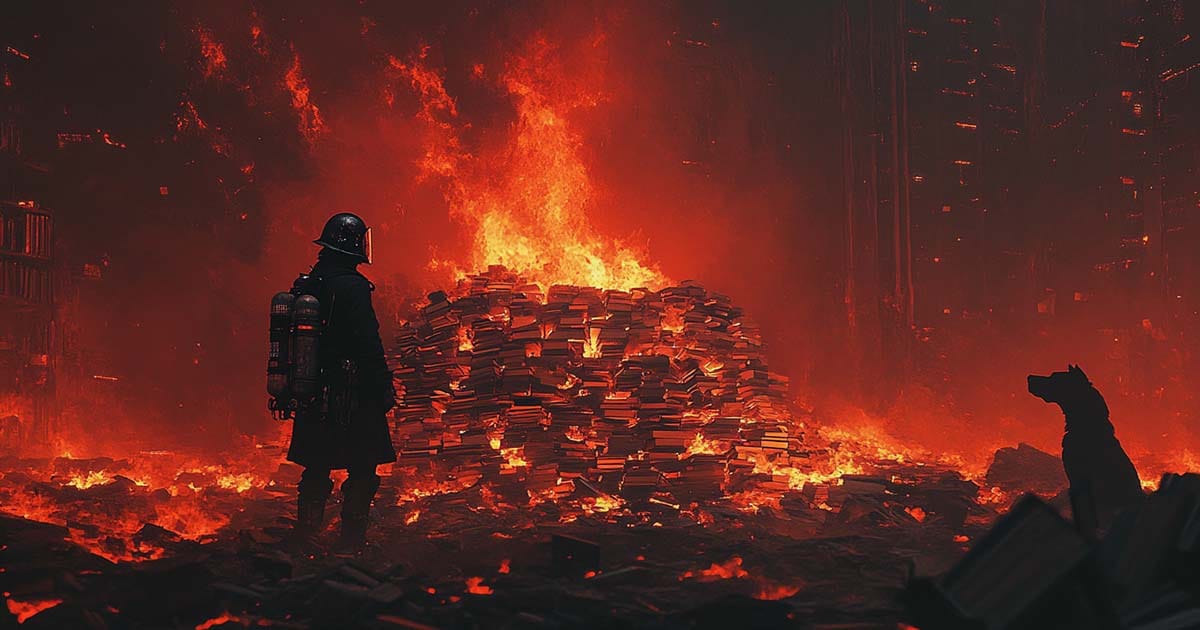Fahrenheit 451 and the Fight Against Forgetting
Ray Bradbury’s “Fahrenheit 451” warned of firemen who burned books. Today, “The Last Archivist” imagines digital firewalls erasing truth, echoing Bradbury’s timeless warning.

This Week in Classic Science Fiction
On October 19, 1953, Ballantine Books published Ray Bradbury’s “Fahrenheit 451” in the United States. At a time when paperbacks were only beginning to be taken seriously, this release helped prove that science fiction could carry the same weight as any literary novel.
Bradbury’s story of firemen who burn books, and of one man who dares to rebel, struck a nerve in a nation wrestling with Cold War anxieties and the shadow of McCarthy-era censorship.
Yet Bradbury’s warning was not only about government repression. He was equally concerned with a culture willing to trade books for screens. “Fahrenheit 451” was as much a critique of passive entertainment as it was of authoritarian firemen. In his world, knowledge disappeared not just through fire, but through neglect.
Seventy years later, the same lesson remains. We may not fear bonfires in the street, but we live in a digital age where information can vanish behind firewalls and algorithms. Each generation faces its own battle to preserve truth, and Bradbury’s novel reminds us that the fight never ends. Whether threatened by flames or by filters, the written word must always be defended.
Sponsored by: Troopers on Mars | मंगल पर ट्रूपर्स | Science Fiction T-shirt

The Troopers on Mars | मंगल पर ट्रूपर्स | Science Fiction T-shirt blends comfort with imagination. Its detailed design of armored soldiers on the Martian frontier recalls the grand pulp adventures of the past while adding a modern artistic touch. Made from soft, pre-shrunk cotton, it is light, durable, and built for everyday wear. This shirt is more than apparel—it is a salute to the timeless spirit of science fiction.
The Last Archivist: From Fire to Firewalls
Ray Bradbury’s “Fahrenheit 451” tells the story of firemen who no longer put out fires but start them, reducing books to ash in the name of social harmony. It was a sharp vision of a world where independent thought was dangerous and conformity was enforced by spectacle. More than seventy years later, Bradbury’s novel remains a touchstone for the dangers of censorship and the fragility of culture.
A Novel Born of Its Time
The book emerged in the 1950s, when the Cold War fueled anxiety and suspicion across America. The McCarthy hearings cast a shadow over intellectual freedom, and the pressure to conform was strong. Against this backdrop, Ballantine Books released “Fahrenheit 451” as an original paperback, giving it both accessibility and a certain boldness.

It joined a line of dystopian works that defined the mid-twentieth century. Orwell’s “1984” warned of the dangers of surveillance and tyranny. Huxley’s “Brave New World” explored a society dulled by pleasure and control. Bradbury added his own vision, one built on fire and the spectacle of destruction, where the war on books became a war on memory itself.
The Fire and the Screen
At the heart of the novel is the fireman Montag, who discovers that the world he serves is built on erasure. The burning of books is not only the destruction of paper, but of identity, thought, and history.
Bradbury also warned against the lure of the screen. He feared a population that would abandon books willingly, trading them for shallow entertainment. In his world, the firemen are not the only villains. The people themselves have allowed their culture to be hollowed out by indifference.
From Pages to Firewalls
The modern reader does not fear bonfires in the street, yet the control of information remains as urgent as ever. In the digital age, knowledge can vanish with the press of a button, hidden behind algorithms, firewalls, and the selective memory of servers. Information may not be burned, but it can be deleted or rewritten, leaving little trace that it ever existed.
This creates a new kind of vulnerability. Where Bradbury’s characters fought to save whole texts by memorizing them, today’s culture depends on fragmented data scattered across countless machines. The risk is not only loss, but distortion.

The Last Archivist
Imagine a world where knowledge is not confined to books or servers, but is instead carried by people themselves in fragments. A forbidden poem might live as a line in one man’s memory implant, another line in someone else, and a hidden phrase in a third. Only when the group gathers can the full work be restored.
In this vision, an Archivist takes on the burden of preserving the fragments and connecting the pieces. Yet the greater danger comes when the governing system begins to rewrite history, not just delete it. In such a world, the Archivist must protect what is true before it is altered beyond recognition.
The parallel to Bradbury’s “Book People” is clear. His wandering exiles each carried a single book in their minds, ensuring that literature would survive even if it could not be written down. The Last Archivist faces a harsher task, as the enemy is not fire but digital manipulation, an erasure that leaves no ashes behind.
The Timeless Warning
Bradbury’s warning was never limited to a single technology or age. His real subject was the ease with which people surrender truth for comfort. Whether through fire, television, or the glow of a screen, the danger lies in forgetting that knowledge requires effort, memory, and protection.
“The Last Archivist” is a way of seeing Bradbury’s vision renewed. It reminds us that the past is never safe, and that each generation must find its own way to guard what is worth keeping. Fire destroyed the written word in Bradbury’s tale. Today, the threats come from silent editing and the vanishing file. The warning is the same.
“Fahrenheit 451” Trivia
- Ray Bradbury wrote the first draft of “Fahrenheit 451” in the basement typing room of UCLA’s Powell Library. He rented the typewriter for ten cents per half hour and finished the draft in just nine days.
- The title “Fahrenheit 451” refers to the temperature at which paper supposedly ignites. Bradbury asked a fire chief to confirm the number, though later experiments showed that paper can burn at slightly different temperatures depending on conditions.
- The first film adaptation, directed by François Truffaut in 1966, was also his first and only English-language film. Truffaut, who admired Bradbury’s work, approached the story as a love triangle between Montag, his wife, and Clarisse.

